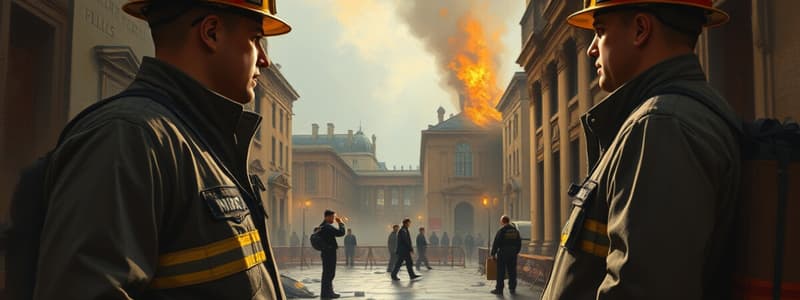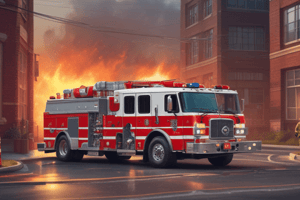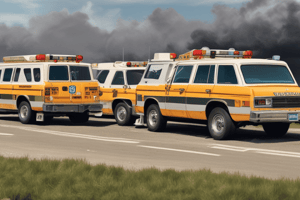Podcast
Questions and Answers
What is one of the essential roles of an incident safety officer (ISO) during a fire incident?
What is one of the essential roles of an incident safety officer (ISO) during a fire incident?
- To communicate the collapse potential of a building to the incident commander (correct)
- To provide medical assistance to injured firefighters
- To lead the firefighting operation
- To check the equipment and gear of firefighters
Which of the following statements reflects the philosophy of Francis L. Brannigan regarding firefighter safety?
Which of the following statements reflects the philosophy of Francis L. Brannigan regarding firefighter safety?
- Firefighters should avoid any communication with incident commanders.
- Firefighters should only focus on extinguishing fires, not on building integrity.
- Building codes are the only factor that influences fire safety.
- Understanding the building's behavior during a fire is critical for firefighter safety. (correct)
How does an ISO predict building collapse during a fire incident?
How does an ISO predict building collapse during a fire incident?
- By consulting with external engineering experts on-site
- By referring to past firefighting experiences
- By relying solely on their instincts
- By applying essential construction concepts and observations (correct)
What did Francis L. Brannigan imply with the phrase, 'Beware the truss!'?
What did Francis L. Brannigan imply with the phrase, 'Beware the truss!'?
What types of loads must a building support according to ISO guidelines?
What types of loads must a building support according to ISO guidelines?
Which statement about the types of loads is correct?
Which statement about the types of loads is correct?
What is a critical responsibility of an ISO in regards to the rapid intervention crew (RIC)?
What is a critical responsibility of an ISO in regards to the rapid intervention crew (RIC)?
Which statement about lightweight buildings is emphasized by Brannigan's teachings?
Which statement about lightweight buildings is emphasized by Brannigan's teachings?
Which factor does NOT influence the time a building will resist collapse during a fire?
Which factor does NOT influence the time a building will resist collapse during a fire?
Which of the following is a late indicator of collapse in a structure during a fire?
Which of the following is a late indicator of collapse in a structure during a fire?
What is the order given by the ISO when imminent collapse is detected?
What is the order given by the ISO when imminent collapse is detected?
How far should exclusion zones generally extend from an unreinforced masonry (URM) wall during a potential collapse?
How far should exclusion zones generally extend from an unreinforced masonry (URM) wall during a potential collapse?
Which statement best describes a general collapse?
Which statement best describes a general collapse?
Which of the following is considered a ‘loser’ building structure?
Which of the following is considered a ‘loser’ building structure?
What type of withdrawal is typically ordered after discussions between the Incident Commander and the ISO?
What type of withdrawal is typically ordered after discussions between the Incident Commander and the ISO?
Which of the following is NOT a typical weak link that may indicate collapse at structure fires?
Which of the following is NOT a typical weak link that may indicate collapse at structure fires?
What is the primary characteristic of ductile materials when subjected to forces?
What is the primary characteristic of ductile materials when subjected to forces?
How does the mass of a material affect its fire resistance?
How does the mass of a material affect its fire resistance?
Which of the following is true about concrete's properties?
Which of the following is true about concrete's properties?
What phenomenon occurs to concrete when it is heated, due to its moisture content?
What phenomenon occurs to concrete when it is heated, due to its moisture content?
What is the primary role of columns within a structural framework?
What is the primary role of columns within a structural framework?
Which statement accurately describes shear forces acting on materials?
Which statement accurately describes shear forces acting on materials?
What type of beam is supported at only one end?
What type of beam is supported at only one end?
What is spalling in concrete construction?
What is spalling in concrete construction?
Which characteristic best distinguishes engineered wood from native wood?
Which characteristic best distinguishes engineered wood from native wood?
How does the construction of a masonry wall typically enhance its load-bearing capability?
How does the construction of a masonry wall typically enhance its load-bearing capability?
What is the effect of increasing temperature on the structural integrity of steel?
What is the effect of increasing temperature on the structural integrity of steel?
Which of the following statements correctly describes how beams respond to loads?
Which of the following statements correctly describes how beams respond to loads?
Which material is commonly reinforced with steel to offset its weakness in tensile strength?
Which material is commonly reinforced with steel to offset its weakness in tensile strength?
What is the primary purpose of establishing a collapse zone?
What is the primary purpose of establishing a collapse zone?
Which of the following is NOT a type of collapse?
Which of the following is NOT a type of collapse?
What defines a ductile material when exposed to forces?
What defines a ductile material when exposed to forces?
Which of the following materials contributes to fire and loses mass when exposed to flames?
Which of the following materials contributes to fire and loses mass when exposed to flames?
What is the NFPA 220 classification for a non-combustible building?
What is the NFPA 220 classification for a non-combustible building?
What type of load is produced when weight is applied off-center to a building?
What type of load is produced when weight is applied off-center to a building?
Which step does NOT belong to the ISO's five-step decision-making process?
Which step does NOT belong to the ISO's five-step decision-making process?
What can cause spalling in concrete when exposed to heat?
What can cause spalling in concrete when exposed to heat?
In terms of construction classification, what does 'Hybrid building' refer to?
In terms of construction classification, what does 'Hybrid building' refer to?
What does a precautionary withdrawal entail in the context of collapse potential?
What does a precautionary withdrawal entail in the context of collapse potential?
What does NOT indicate potential issues in a structure based on spreaders?
What does NOT indicate potential issues in a structure based on spreaders?
Which material is known for burning rapidly and degrading from heat, commonly used in wood construction?
Which material is known for burning rapidly and degrading from heat, commonly used in wood construction?
What does 'load-bearing portions of a building' refer to?
What does 'load-bearing portions of a building' refer to?
What is the primary purpose of categorizing a building by its occupancy type?
What is the primary purpose of categorizing a building by its occupancy type?
Which element is NOT considered in determining building size according to the ISO?
Which element is NOT considered in determining building size according to the ISO?
In the five-step process for predicting collapse, which step involves visualizing and tracing loads?
In the five-step process for predicting collapse, which step involves visualizing and tracing loads?
What does it mean when a fire in a building is classified as a 'structure fire'?
What does it mean when a fire in a building is classified as a 'structure fire'?
Which of the following factors is NOT a time truism for predicting collapse?
Which of the following factors is NOT a time truism for predicting collapse?
What should be the immediate focus once a structure is involved in a fire?
What should be the immediate focus once a structure is involved in a fire?
Which of the following is NOT a key recommendation by NIOSH regarding truss systems?
Which of the following is NOT a key recommendation by NIOSH regarding truss systems?
How does the ISO define the structural involvement of a fire?
How does the ISO define the structural involvement of a fire?
What does the term 'visualizing and tracing loads' generally imply within collapse prediction?
What does the term 'visualizing and tracing loads' generally imply within collapse prediction?
Which observation is NOT indicative of an increased likelihood of collapse?
Which observation is NOT indicative of an increased likelihood of collapse?
What is a critical factor that could accelerate the potential time to collapse?
What is a critical factor that could accelerate the potential time to collapse?
During which step of predicting collapse is the decision communicated?
During which step of predicting collapse is the decision communicated?
Which of the following steps is considered analytical in the collapse prediction process?
Which of the following steps is considered analytical in the collapse prediction process?
What is the primary purpose of purlins in construction?
What is the primary purpose of purlins in construction?
Which type of connection involves elements that are bonded together to form a solid union?
Which type of connection involves elements that are bonded together to form a solid union?
What are the primary concerns regarding fire in Type III construction?
What are the primary concerns regarding fire in Type III construction?
In which construction classification is rapid collapse a significant concern due to the burning contents’ heat release?
In which construction classification is rapid collapse a significant concern due to the burning contents’ heat release?
What defines a hybrid building in construction classifications?
What defines a hybrid building in construction classifications?
Which of the following is NOT an example of Type I construction?
Which of the following is NOT an example of Type I construction?
Which era introduced minimal fire stopping and larger buildings with unprotected steel?
Which era introduced minimal fire stopping and larger buildings with unprotected steel?
What is the main fire and collapse concern for Type IV heavy timber buildings?
What is the main fire and collapse concern for Type IV heavy timber buildings?
What is a key characteristic of Type V wood frame construction?
What is a key characteristic of Type V wood frame construction?
What does the term 'platform framing' refer to in the context of construction eras?
What does the term 'platform framing' refer to in the context of construction eras?
What is a significant risk when dealing with buildings constructed in the lightweight era?
What is a significant risk when dealing with buildings constructed in the lightweight era?
What happens during fires in buildings with masonry walls in ordinary construction?
What happens during fires in buildings with masonry walls in ordinary construction?
Which construction type is primarily comprised of metal or noncombustible materials but may still face rapid collapse under fire conditions?
Which construction type is primarily comprised of metal or noncombustible materials but may still face rapid collapse under fire conditions?
Which type of construction utilizes expanded polystyrene for forming walls?
Which type of construction utilizes expanded polystyrene for forming walls?
Which element is considered a common weak link in structural failure, especially during fires?
Which element is considered a common weak link in structural failure, especially during fires?
Flashcards are hidden until you start studying
Study Notes
Introduction to Building Collapse Risks
- Incident Safety Officers (ISOs) provide crucial assessments on potential building collapses during firefighting operations.
- Effective communication of construction features to Rapid Intervention Crews (RICs) ensures that contingencies can be strategized.
- ISOs leverage a robust knowledge base to evaluate and communicate possible collapse threats.
Insights from Francis L. Brannigan
- Brannigan emphasized understanding building hazards to prevent firefighter accidents.
- Key phrases from Brannigan:
- "The building is the enemy—know your enemy."
- "Beware the truss!" highlighting structural vulnerabilities.
- Observed that column failure should trigger immediate evacuation.
- Claimed lightweight buildings are often "disposable," unlike trained firefighters.
Essential Building Construction Concepts
- Predicting Collapse:
- ISOs must interpret building features and fire behavior to assess collapse risks effectively.
- Load Types:
- Dead Load: Permanent weights of the building structure.
- Live Load: Temporary forces (e.g., occupants, furniture).
- Load Impositions:
- Loads may be imposed axially, eccentrically, or torsionally, each impacting structural integrity.
- Material Response:
- Different materials exhibit varied responses to loads: compression, tension, and shear affect how they can bear weight or heat.
Characteristics of Building Materials
- Structural materials are categorized based on their resistance to fire and load-bearing capabilities.
- Wood: Ductile with low force resistance; engineered variants may fail under heat.
- Steel: Strong yet loses strength at high temperatures, posing significant risks during fires.
- Concrete: Strong compressive material but prone to spalling; reinforced with steel for added strength.
- Masonry: Notably strong but mortar may crack under heat, compromising structural integrity.
- Composites: Include various engineered products (e.g., I-joists) that can fail quickly when heated.
Structural Elements
- Columns: Transfer compressive forces, supporting beams and walls vital for building stability.
- Beams: Designed to carry loads that create tension and compression, with various types (simple, continuous, cantilever).
- Connections: Often the weakest point during fires; classified as pinned, rigid, or gravity connections.
Construction Classifications
- Classifications are based on construction type, era, intended use, and size.
- Type I: Noncombustible materials with high fire resistance (e.g., high-rises).
- Type II: Noncombustible but relies on interior contents for fire spread.
- Type III: Combination of noncombustible walls with combustible wooden components.
- Type IV: Heavy timber with significant thickness; rare in modern construction.
- Type V: Common wood-frame structures prone to rapid fire spread.
- Hybrid Types: Features of multiple classifications; less research found on their behavior during fires.
Predicting Collapse
- An ongoing assessment of structural integrity in response to changing conditions is essential.
- Identify–Analyze–Decide Method: A systematic approach for predicting collapse likelihood.
- Steps for Assessment:
- Classify building using type/era/use/size.
- Analyze structural components involved in the fire.
- Visualize load paths and potential vulnerabilities.
- Consider the timeline for potential collapse under various conditions.
Evaluating Time and Risks
- Several factors can accelerate collapse, including structural mass, imposed loads, and firefighting operations.
- Key insights for predicting collapse:
- Lightweight structures collapse faster.
- Heavier loads can hasten the failure of supports.
- Fire resistive barriers may degrade over time due to negligence.
Conclusion and Final Assessment
- Accurately predicting collapse necessitates comprehensive evaluations much before physical signs manifest.
- Observations such as deteriorations, cracking, and unexpected repairs are critical indicators of potential failure.### Structural Indicators of Potential Collapse
- Bulges and bowing of walls signal possible structural compromise.
- Sagging floors and roofs indicate potential failure zones.
- Abandoned buildings with missing segments are at higher collapse risk.
- Ongoing construction, renovation, or demolition can affect building stability.
- Large volumes of fire can severely weaken structural components.
- Multiple fires or previous damage raise the likelihood of collapse.
- Settling noises may suggest structural movement or instability.
- Doors that are out of plumb or jammed can indicate structural shifts.
- Inconsistencies in water flow suggest internal issues versus external inputs.
Collapse Zone Establishment
- Collapse zones are areas at risk from debris or trauma due to building failures.
- These zones serve as no-entry areas for safety, including firefighters.
- Zone distance typically ranges from 1.5 to 3 times the height of the structure at risk.
Types of Structural Collapse
- Partial Collapse: Building can sustain the failure of a single component with remaining strength.
- General Collapse: Complete structural failure under gravity’s influence.
- Secondary Collapse: Occurs after a partial collapse, leading to further failures.
Collapse Communication Strategies
- Emergency Abandonment: Immediate retreat of all personnel when imminent collapse is detected.
- Precautionary Withdrawal: Organized exit in less urgent situations.
- Planning Awareness: Adjustments to incident action plans based on risk assessments.
Fire Dynamics and Material Behavior
- Understanding loads: static (dead loads from the building's weight) and dynamic (live loads from additional weight).
- Loading methods include axial, eccentric, and torsional forces.
- Forces exerted on materials can be compressive, tensile, or shear.
- Materials have resistance characteristics; ductile materials deform while retaining strength, while brittle materials fracture.
Fire Impact on Building Materials
- Wood contributes fuel to fires and loses mass during combustion.
- Steel does not burn but loses integrity upon heating.
- Concrete and masonry crack but do not contribute to fires; spalling occurs due to moisture expansion when heated.
- Laminated Veneer Lumber (LVL) and Oriented Strand Board (OSB) burn rapidly and degrade from heat exposure.
Structural Elements
- Primary load-bearing components include columns, beams, and connections.
- Columns resist compressive forces; beams distribute loads and may utilize conventional or truss construction.
- Connections can be classified as gravity, pinned, or rigid.
Building Classification and History
- Classification systems include the NFPA 220, covering types I-V based on fire resistance and materials.
- Hybrid constructions mix elements from multiple classifications.
- Historical eras (founders’, industrial, legacy, lightweight) influence materials and construction methods, affecting fire behavior and collapse risks.
Weak Links and Indicators of Collapse
- Common indicators include connection points, truss systems, overloaded structural elements, and large spans.
- Late-stage indicators involve sagging, cracks, bulging walls, and significant fire presence.
Risk Assessment Process for ISOs
- Identify building type, era, use, and size.
- Locate fire and heat sources affecting structural integrity.
- Analyze load transference and identify vulnerabilities.
- Assess the impact of time on material properties.
- Communicate collapse potential and establish collapse zones effectively.
Collapse Communication Importance
- ISO judgments on collapse potential are critical for incident command and rapid intervention crews.
- Urgent communication to ensure safety and operational effectiveness is necessary given the unpredictability of structural integrity during firefighting operations.
Studying That Suits You
Use AI to generate personalized quizzes and flashcards to suit your learning preferences.




